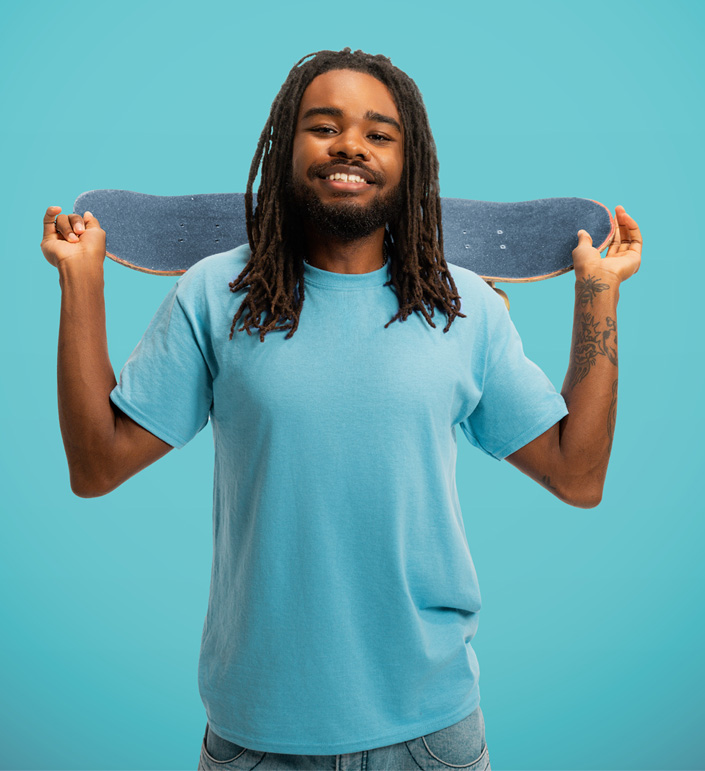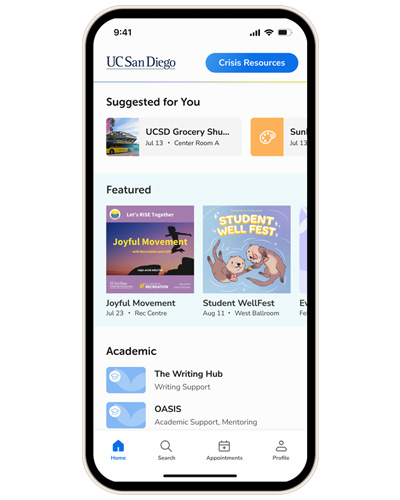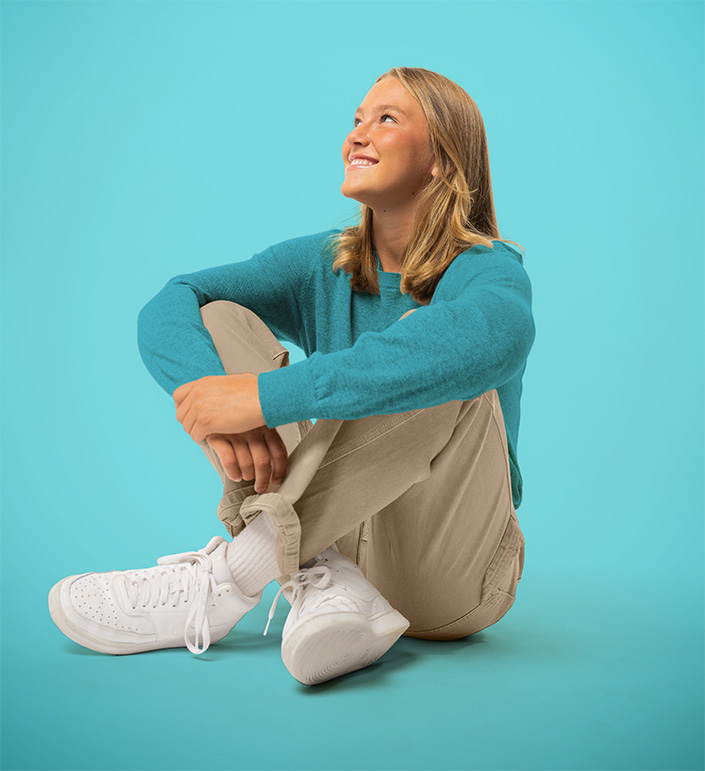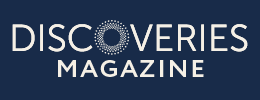Wealth of Wellness
UC San Diego launches groundbreaking Willo app to support student well-being.
Published Date
Article Content
This story is from the 2025 issue of Discoveries, a UC San Diego Health Sciences magazine.
A world map adorned with pushpins hangs on the wall of a workspace in the University of California San Diego’s Design and Innovation Building, representing the hometowns of many students who worked on the university’s groundbreaking self-care app, Willo. “Our hometowns are spread across the globe,” said Manas Bedmutha, a third-year PhD student and architect of the app’s Artificial Intelligence (AI). “Our upbringing and our way of thinking is diverse. We represent different people on campus to guarantee everyone’s voice is heard.”

The heart of Willo lies in ensuring the app for enrolled UC San Diego students is built by those who know them best: their peers. Students collaborated for more than two years with faculty and staff from UC San Diego Student Health and Well-Being and Jacobs Center for Health Innovation (JCHI) at UC San Diego Health to keep Tritons at the forefront of Willo. Through months of interviews, workshops, surveys, focus groups and user testing, the app’s design remained student-centered. Its intuitive system aggregator integrates the university’s extensive health and well-being services into a user-friendly platform, making this app the first of its kind.
“Willo is a testament to the hard work, dedication and innovative approach of Student Health and Well-Being, Jacobs Center for Health Innovation and our forward-thinking and compassionate UC San Diego students,” said Patty Maysent, CEO of UC San Diego Health. “I am so inspired by UC San Diego’s commitment to student health and well-being and our dedication to providing our communities with greater access to world-class, holistic health care.”
Facing the Rising Tide of Mental Health Challenges
Globally, universities are seeing significant increases in mental health-related incidents and an increased demand for access to well-being support, said Ed Junkins, MD, executive director of UC San Diego’s Student Health and Well-Being.
To help address the issue, UC San Diego received a $5 million budget appropriation from the state of California with one parameter: create a mental health platform for students. With this funding, a team of over 100 students, faculty and staff began investigating why the campus’s vast array of wellness resources weren’t being widely used.
“All students pay for mental health services as part of their tuition, and our on-campus counseling is free, yet only 10% of our 43,000 students use our counseling services,” said Junkins.
“All students pay for mental health services as part of their tuition, and our on-campus counseling is free, yet only 10% of our 43,000 students use our counseling services."
The group cast a wide net: what do the students — the end users — need, what are they currently using and what are they lacking? After months of research, they realized that they had to develop a mobile app with an AI-enabled recommendation engine that simplified access to self care resources offered by the university in a way that was tailored to students’ unique needs. To do that, the app needed to follow a stepped model of care to reach students before they required clinical intervention while easing the pathway to higher and more intensive interventions.
While many think of self-care resources as only those that are overtly related to one’s mental health, such as meditation, nutrition or exercise, according to Nicole May, JCHI’s co-director, well-being is much more.
Willo is organized based on the wellness wheel, a widely used well-being tool defined by eight dimensions of wellness: emotional, environmental, financial, intellectual, occupational, physical, social and spiritual. The Willo team modified the dimensions to serve UC San Diego’s students: academic, arts and culture, basic needs, career, communities, mental health and wellness, physical health and spirituality.
“We wanted to connect students with events, resources or services that help them find a well-being balance,” May shared. “It was more about uncovering what really impacts their mental health and providing resources. The app needed to address all elements of their lives that could cause stress, anxiety or depression.”
Defining What Students Need
In the initial stages of the app’s design, the team considered building an aggregator to simply present the university’s vast slate of offerings within those eight categories. Like a library with shelves of cataloged books, the app would use a similar approach by presenting users with options to “check out.”
By first defining what the users needed from a well-being app rather than building out the technology and waiting for reviews, the design team found that the app had to lessen the user’s cognitive burden. Merely presenting an aggregated list of options would not be enough; the app had to provide the user with tailored recommendations.
“Today’s generation is very tuned into self-help resources they can drive and customize,” Junkins shared. “It’s that idea of having what you want, when and how you want it. Mental health and well-being resources are no different.”
Student involvement in the app was the driving force behind the final design. “If you asked a group of staff and administrators to develop an app for students, I don’t think this is the app we would have,” revealed May. “Students today are different than they were even four years ago. We needed to support a sense of belonging and connection within the university, which could go a long way to helping students feel less isolated or stressed.”
“JCHI thinks so much with the student in mind and not in place of the student,” shared product designer Jarenz Castillo, a fourth-year cognitive science and interdisciplinary computer and the arts major. “They always listen to what we have to say because at the end of the day, we’re the end users.”
In addition to being a user-driven platform, the app also endeavored to build a wellness ecosystem for all students — a place that shows everything wellness-related on campus, whether that’s Counseling and Psychological Services, Career Center programming, a Recreation Activity Pass, Craft Center classes and workshops, peer counseling or student-centered, identity-based communities.
“Wellness has different types and forms,” Bedmutha said. “It can be about your academic and personal growth, it can be about your mental and physical state, or it can be about your sense of social belonging.”
Building Human-Centered AI for Students, by Students
After analyzing their research, the Willo team knew that the app had to guide the user and act more like a librarian, asking detailed questions to get to the heart of the issue and then make tailored recommendations. Willo would provide a space for users to self-select their own needs and interests and then receive recommendations. This is the heart of the app’s human-centered design.
“The AI in this app started out as more of a feature but ended up becoming one of the main characters of the story,” shared Bedmutha, a member of the Human-centered eXtended Intelligence research lab. “Similar to how Instagram has hashtags, the currency of our ‘recommender’ system is the tags people choose. Users can just select or follow a few, then the AI provides recommendations that support those tags.”
Willo’s human-centered AI also relies on a key point: the willingness of its users to engage with the app. As the app’s algorithm collects more information from the user through their interactions, the recommender system becomes more nuanced and tailored to the user.
“As a researcher, I’ve been trying to understand how willing people are to share information about their well-being,” Bedmutha said. “If there is limited willingness because the user prefers to keep that information private, how do we build algorithms that are still effective in providing recommendations or making predictions?”
Respecting the user’s willingness to share, the app takes precautions to protect their identity. Designers cannot identify a user by their ID; they can only see their usage history and selected tags. By connecting to the user’s MyStudentChart, UC San Diego’s health portal, Willo provides a secure HIPAA-protected data environment maintained by the UC San Diego Health system.
Inside the App
So how exactly does the app work?

Students sign in to the app using their campus login credentials and can connect their account to their MyStudentChart. Users then personalize their experience by identifying specific areas of wellness they’d like to explore from a list of options — or “tags” — that are sorted into the eight categories that match the wellness wheel. For example, a user can select options in the “Mental Health and Wellness” category that include “Peer Support,” “Yoga,” “Athlete Well-being” and “Anxiety Management.” The app then provides a list of resources or events suggested for the user within each category based on their responses.
The “tagging” sorts resources or events into categories to capture the full spectrum of offerings. The Willo team did an extensive amount of tagging, which, according to Bedmutha, “is the secret sauce to the app producing the best, most customized recommendation.”
Users can also search for resources in the app, explore by category and see Student Health Services appointments. Experiences like athletic games, recreation classes or career fairs are pulled in real time using a direct interface to the systems in which they’re housed.
Additionally, crisis resources are prominently featured in the app. For example, users can see locations and find directions to their nearest emergency room or learn what to expect when they call a crisis line.
Over time, Willo’s AI monitors likes, shares and time spent on certain resources to understand each user’s interests and offer more nuanced selections. The Willo design team also mapped the journey of a student across each quarter, being mindful of their wellness at various points of the academic year, which, in future versions, will inform recommendations provided by the app.
“Willo can connect you to people and resources you didn’t know you needed,” said sophomore UI/UX designer Kyla Bruhn. “The more you engage with the app, the more it can help you. It’s there to help you as a student and in the real world. It’s a very mind-settling app.”
The Impact of Willo
For Bruhn, a second-year student majoring in human developmental sciences and a member of the water polo team, the opportunity to work on Willo has been incredibly rewarding.
“As an incoming freshman last year, I wish I’d had Willo,” she said. “This app has everything a student could want to find about wellness resources across the entire university. It opens a lot of doors, helping us start conversations and ease stress and concerns in ways that students prefer. This app is going to help a lot of people.”
"The more you engage with the app, the more it can help you. it’s there to help you as a student and in the real world. it’s a very mind-settling app."

A fourth-year student, Castillo noted that, since using the app, he and his classmates have uncovered resources they’ve always had access to but didn’t know about or where to find. “The app really helps promote your individuality,” he shared. “It doesn’t force you to be any way. It just gives you a little nudge to take that extra step for yourself.”
Willo recognizes that students want to take control of their wellness and, through the unwavering passion of those who work on the app, it will continue to evolve in future versions.
“Being involved in Willo has been the perfect way for me to contribute to UC San Diego, which has given me so much in the last three years,” said Bedmutha, who has been involved with the app since its beginnings. “We’re trying to be a wellness ecosystem and not just another mental health app.”
Future versions of the app are expected to offer more nuanced suggestions, push notifications and the ability to connect and share with friends. “The app is only going to get better,” Bruhn revealed. “I’m really happy with what’s in store.”
“A lot of work and input was put into this app,” Junkins added. “We’re hoping to achieve an overall improved level of student health and wellness. If things go as we predict, this app will impact a lot of people across the entire community.”
“Willo is designed specifically to address the mental health needs of our diverse community,” said Chancellor Pradeep K. Khosla. “This trailblazing app reflects the collaborative nature and innovative ethos of our campus and long history of leadership in AI. By introducing this transformative AI algorithm, we are delivering on our mission to prioritize student health and well-being, with a strong focus on mental health support.”
Share This:
You May Also Like
Engineers Take a Closer Look at How a Plant Virus Primes the Immune System to Fight Cancer
Technology & EngineeringStay in the Know
Keep up with all the latest from UC San Diego. Subscribe to the newsletter today.





